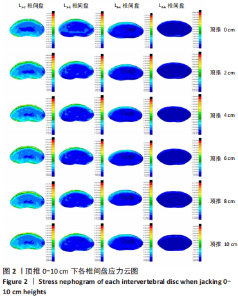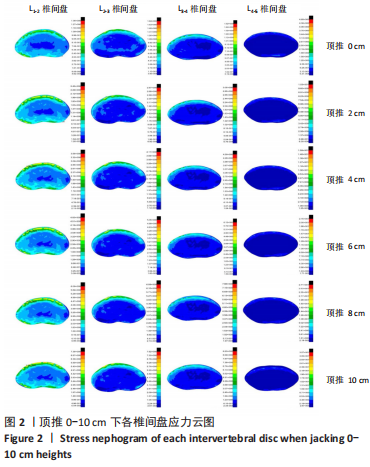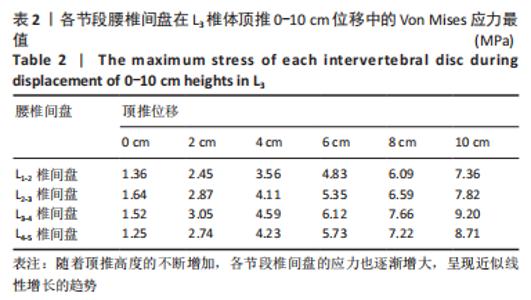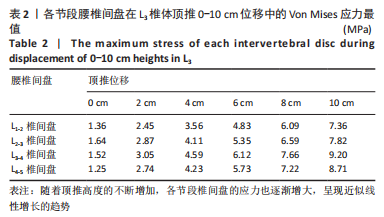[1] 李民,董竑麟,汪桂珍,等.有限元分析不同牵伸时长相邻腰椎节段和椎间盘应力及位移的变化[J].中国组织工程研究,2020,24(21):3281-3286.
[2] ZHU QQ, GAO X, LEVENE HB, et al. Influences of Nutrition Supply and Pathways on the Degenerative Patterns in Human Intervertebral Disc. Spine (Phila Pa 1976). 2016;41(7):568-576.
[3] 王和鸣,王诗忠.南少林理筋整脊手法图谱[M].北京:中国中医药出版社,2015:1-2.
[4] 陈福建,李永军,苏丽君.南少林整脊手法治疗腰椎间盘突出症的疗效观察[J].深圳中西医结合杂志,2019,29(12):43-45.
[5] 刘发元,翁霞萍,吴超雄,等.南少林理筋整脊手法治疗腰椎间盘突出症89例临床观察[J].风湿病与关节炎,2019,8(10):28-31.
[6] 张大勇,张凌岚.功夫整脊[M].福州:福建科学技术出版社,2011:31.
[7] MASNI-AZIAN, MASAO T. Biomechanical investigation on the influence of the regional material degeneration of an intervertebral disc in a lower lumbar spinal unit: A finite element study. Comput Biol Med. 2018;98:26-38.
[8] SHEN H, FOGEL GR, ZHU J, et al. Biomechanical analysis of different lumbar interspinous process devices: A finite element study. World Neurosurg. 2019;127:1112-1119.
[9] 张瑜,李忠海.三维有限元法在脊柱生物力学中的应用现状[J].中国骨与关节杂志,2020,9(3):220-224.
[10] XU M, YANG J, LIEBERMAN I, et al. Stress distribution in vertebral bone and pedicle screw and screw-bone load transfers among various fixation methods for lumbar spine surgical alignment: A finite element study. Med Eng Phys. 2019;63:26-32.
[11] SPINA NT, MORENO GS, BRODKE DS, et al. Biomechanical effects of laminectomies in the human lumbar spine: a finite element study. Spine J. 2021;21(1):150-159.
[12] 苏晋.腰椎有限元模型的建立与生物力学分析[D].大连:大连医科大学,2016.
[13] 邓海峰.腰骶椎三维有限元建模及三种内固定方式生物力学分析[D].沈阳:中国医科大学,2011.
[14] 沈永乐.新型腰椎后路动态内固定系统固定腰椎滑脱有限元分析[D].沈阳:中国医科大学,2012.
[15] LO CC, TSAI KJ, ZHONG ZC, et al. Biomechanical differences of Coflex-F and pedicle screw fixation combined with TLIF or ALIF--a finite element study. Comput Methods Biomech Biomed Engin. 2011;14(11):947 -956.
[16] PANJABI MM, OXLAND TR, YAMAMOTO I, et al. Mechanical behavior of the human lumbar and lumbosacral spine as shown by three-dimensional load-displacement curves. J Bone Joint Surg Am. 1994;76(3):413-424.
[17] XIAO ZT, WANG LY, GONG H, et al. Biomechanical evaluation of three surgical scenarios of posterior lumbar interbody fusion by finite element analysis. Biomed Eng Online. 2012;11(1):1-11.
[18] Robertson DGE, Caldwell GE, Hamill J, et al. Research Methods in Biomechanics. 2013:69.
[19] 吕立红,金叶道,郑如云,等.不同作用方向的整复手法治疗腰椎间盘突出症临床疗效观察[J].中国骨伤,2009,22(4):257.
[20] 王强,孙波.整骨类手法治疗腰椎间盘突出症研究概况[J].按摩与康复医学,2014(11):25-27.
[21] 尚永,张人文,莫灼锚,等.腰椎退变影响拔伸按压手法生物力学作用的有限元研究[J].山东中医药大学学报,2019,43(2):151-154.
[22] 庞胤,尹帅,赵长义,等.脊柱腰段三维有限元模型的构建与椎间盘应力分析[J].河北医科大学学报, 2019,40(12):1368-1371.
[23] 田强,钟侨霖,赵家友,等.提拉旋转斜扳法操作时腰椎椎间盘应力及应变的有限元研究[J].中国临床解剖学杂志,2019,37(1):83-86.
[24] 陈忻,于杰,冯敏山,等.坐位旋转手法治疗退行性腰椎滑脱的椎间盘力学分析[J].中华中医药杂志, 2019,34(4):1395-1400.
|



